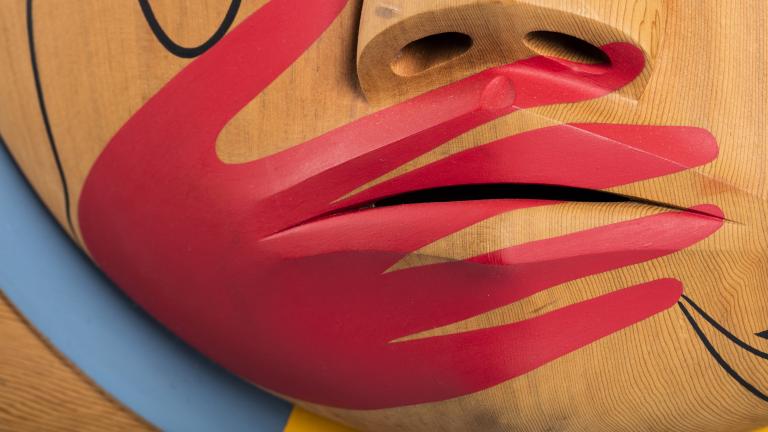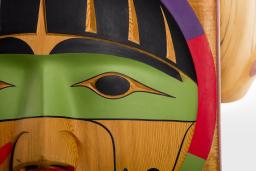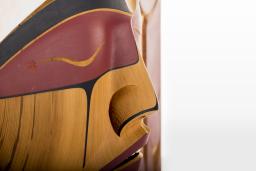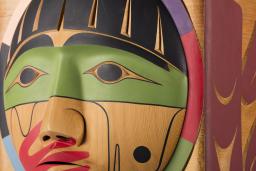As a child, I often visited museums. I was lucky to be able to travel with my family, and to visit interpretive spaces across the country.
The nuts and bolts of reconciliation
By Karine Duhamel
Published: November 18, 2016
Tags:

Photo: CMHR, Aaron Cohen
Story text
What struck me the most about these spaces was the idea of time – or rather, timelessness – which seemed to characterize all of the dusty artefacts behind glass. Especially in the case of Indigenous artefacts, these displays seemed to signal that something bad had happened, that Indigenous peoples were cultures of the past. The story the exhibits told to me and to other visitors was that my grandmother’s culture was dead – and like the dinosaurs, it belonged in a different era.
Since the 1990s, many museums have been redesigning these exhibits and spaces. These processes, along with the larger process of rethinking museums, are all part of a larger movement focused on integrating and profiling Indigenous perspectives as living, breathing, contemporary ways of knowing and being.
In 2015, the Truth and Reconciliation Commission of Canada (TRC) published its Calls to Action. These underscore the way that museums and archives have traditionally withheld essential truths about history. They called on museums and archives to “fully adopt and implement the United Nations Declaration on the Rights of Indigenous Peoples… as related to Aboriginal peoples’ inalienable right to know the truth about what happened and why”, both in residential schools and beyond.
In the simplest terms, the recommendations of the TRC mean that museums need to be important sites of truth‐telling and reconciliation. What does this mean for Canada’s human rights museum? It means that, as a curator, I am constantly thinking not only about the what, but about the how. In other words, how can I as a researcher make sure that Indigenous peoples are involved in a meaningful and respectful way in the exhibits in which they are featured, and that the story they want to tell is told? Partly, this means taking more time to consult with Elders, individuals and organizations about what matters to them. In addition, it means making sure that we don’t treat the story as a final one and that we highlight, in every way possible, the work left to be done. Finally, this vision means working in partnership to bring new stories to the public.
In May 2016, the Museum was proud to present Take the Indian: A Vocal Reflection on Missing Children. This work by Andrew Balfour, artistic director at Camerata Nova, takes an unflinching look at the power of words, both those of the abuser and those of the survivor. The piece features difficult content related to the experience of residential schools and the vivid recollections of abuse. Take the Indian is about truth‐telling: it is about difficult knowledge, and the need to know it. It is about the past, the present, and the future.
In other words, it is exactly the kind of performance that matters. Why? Take the Indian doesn’t try to bury the hurt or the pain. This piece confronts the past head‐on. It shows the scars that survivors and their descendants still bear from this history. And, importantly, it helps to explain why as individuals, we cannot turn our eyes. It underscores that the future is all of our responsibility.
In past blogs, I’ve mentioned reconciliation as a process built on hope – I believe that. But it’s important to keep in mind, as both an individual and an institution, that difficult knowledge and hard truths are part and parcel of this. Just because something is based on hope does not erase the need to reflect on what has been done in the past.
The TRC has called on museums and archives to be leaders, and we strive to realize this vision.
Museums can be sites of power for understanding reconciliation, but only if the process we follow acknowledges that museums have in the past played a role in misrepresenting Indigenous world views. For the Museum, the Calls to Action mean engaging in new processes and methods with Indigenous communities, asking new, difficult, questions, and being willing to confront the truth – not as we wish it were, but as it was lived and continues to be lived by generations of people.
Dive Deeper
Why reconciliation? Why now?
By Karine Duhamel
Since the publication of the Truth and Reconciliation Commission of Canada’s final report in 2015, more and more Canadians seem focused on the idea of reconciliation.

Reconciliation: A movement of hope or a movement of guilt?
By Karine Duhamel
In Why reconciliation? Why now? I talked about the idea of reconciliation as an invitation to a new and shared future and as a pathway towards a good life, both for Indigenous people and for other Canadians.

Truth and reconciliation: What’s next?
By Karine Duhamel
This article series has focused on the way we present Indigenous content within the Museum and how we are approaching reconciliation.

Suggested citation
Suggested citation : Karine Duhamel. “The nuts and bolts of reconciliation.” Canadian Museum for Human Rights. Published November 18, 2016. https://humanrights.ca/story/nuts-and-bolts-reconciliation